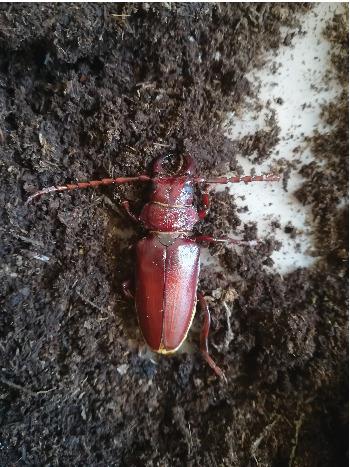当前位置:
X-MOL 学术
›
Agric. For. Entomol.
›
论文详情
Our official English website, www.x-mol.net, welcomes your
feedback! (Note: you will need to create a separate account there.)
Host range determination in a novel outbreak pest of sugarcane, Cacosceles newmannii (Coleoptera: Cerambycidae, Prioninae), inferred from stable isotopes
Agricultural and Forest Entomology ( IF 1.6 ) Pub Date : 2021-03-24 , DOI: 10.1111/afe.12439 Chantelle Smit 1 , Marion Javal 1 , Desmond E. Conlong 1, 2 , Grant Hall 3 , John S. Terblanche 1
中文翻译:

从稳定同位素推断出的一种新型甘蔗暴发害虫 Cacosceles newmannii(鞘翅目:天牛科、栉科)的宿主范围确定
更新日期:2021-03-24
Agricultural and Forest Entomology ( IF 1.6 ) Pub Date : 2021-03-24 , DOI: 10.1111/afe.12439 Chantelle Smit 1 , Marion Javal 1 , Desmond E. Conlong 1, 2 , Grant Hall 3 , John S. Terblanche 1
Affiliation

|
- An outbreak of Cacosceles newmannii (Coleoptera: Cerambycidae) was detected for the first time on sugarcane (Saccharum spp.) in 2015 in KwaZulu-Natal, South Africa. Although primary host plants of this native species remain unknown, these are central to testing hypotheses concerning the outbreak.
- We hypothesized that this species has undergone a host plant shift (i.e. a feeding association with a novel host plant).
- We compared δ13C and δ15N ratios of adult beetles retrieved from South African museum collections, collected between 1891 and 2016 (n = 23; ‘pre-outbreak’), with samples from infested fields in 2017 (n = 9, ‘post-outbreak’) and in 2019 (n = 23, ‘post-outbreak’), as well as diverse, plausible host plants (n = 42 samples across 10 species) from infested fields and surrounding patches of indigenous and commercial forest vegetation. We used Bayesian isotope mixing models to infer the relative contribution of the different plants to the diet of C. newmannii.
- Pre-outbreak, C3 plants contributed strongly to the larval diet, whereas post-outbreak, C4 plants were the largest component of their diet. There was some indication of C4 plants contributing to their diet pre-outbreak.
- Our results suggest that the outbreak of this polyphagous beetle was not a dramatic host shift but rather a rapid increase in the proportion of C4 plants already in their diet.
- We concluded that plants from the families Fabaceae and Poaceae are the most likely host plants of this species. Nevertheless, the drivers of this rapid outbreak on sugarcane remain poorly determined and should be the focus of future research.
中文翻译:

从稳定同位素推断出的一种新型甘蔗暴发害虫 Cacosceles newmannii(鞘翅目:天牛科、栉科)的宿主范围确定
- 2015 年在南非夸祖鲁-纳塔尔省的甘蔗(Saccharum spp.)上首次发现了Cacosceles newmannii(鞘翅目:天牛科)的暴发。尽管这种本地物种的主要寄主植物仍然未知,但这些是检验有关爆发的假设的核心。
- 我们假设该物种经历了寄主植物转变(即与新型寄主植物的摄食关联)。
- 我们比较了1891 年至 2016 年间从南非博物馆藏品中回收的成年甲虫的δ 13 C 和 δ 15 N 比率(n = 23;“爆发前”),以及来自 2017 年受侵染田地的样本(n = 9,“爆发后”)和 2019 年(n = 23,“爆发后”),以及 来自受侵染田地和周围土著和商业森林植被斑块的多样化、合理的寄主植物(n = 10 个物种的 42 个样本)。我们使用贝叶斯同位素混合模型来推断不同植物对C. newmannii饮食的相对贡献。
- 爆发前,C 3植物对幼虫的饮食贡献很大,而爆发后,C 4植物是其饮食的最大组成部分。有一些迹象表明 C 4植物有助于它们在爆发前的饮食。
- 我们的结果表明,这种多食甲虫的爆发并不是宿主的戏剧性转变,而是它们饮食中已经存在的 C 4植物比例的快速增加。
- 我们得出结论,豆科和禾本科植物是该物种最有可能的寄主植物。然而,甘蔗这种快速爆发的驱动因素仍然不确定,应该成为未来研究的重点。











































 京公网安备 11010802027423号
京公网安备 11010802027423号